Physical Address
304 North Cardinal St.
Dorchester Center, MA 02124
The anus comprises a relatively small anatomic region of the gastrointestinal tract, yet it plays a critical role in fecal continence and defecation. Because of its unique anatomy and physiology, the anus can present challenges to diagnosis and treatment. Although malignancy can occasionally develop, the anus is susceptible to a variety of common benign conditions that may cause considerable suffering and greatly impair a patient’s quality of life. Understanding the applied anatomy and physiology of the anus is an invaluable asset to the surgeon and remains the cornerstone of accurate diagnosis and treatment.
The anal canal, as defined by the surgeon/clinician, is approximately 4 cm in length, extending from the anal verge to the top of anorectal ring; the anatomist considers the anus to be the2 cm from the anal verge to the dentate line ( Fig. 53.1 ). The anus appears as an anteroposterior slit-like cutaneous opening, with its distal-most aspect referred to as the anal verge. The proximal anal canal is typically lined by columnar epithelium and the distal anus by squamous epithelium. The junction between the ectoderm and the endoderm, located at the midpoint of the anal canal, appears as an undulating demarcation referred to as the dentate line. Between the dentate line and the anal verge, the mucosa is lined by a modified squamous epithelium, similar to the epithelium of the skin, but devoid of hair follicles and glands.
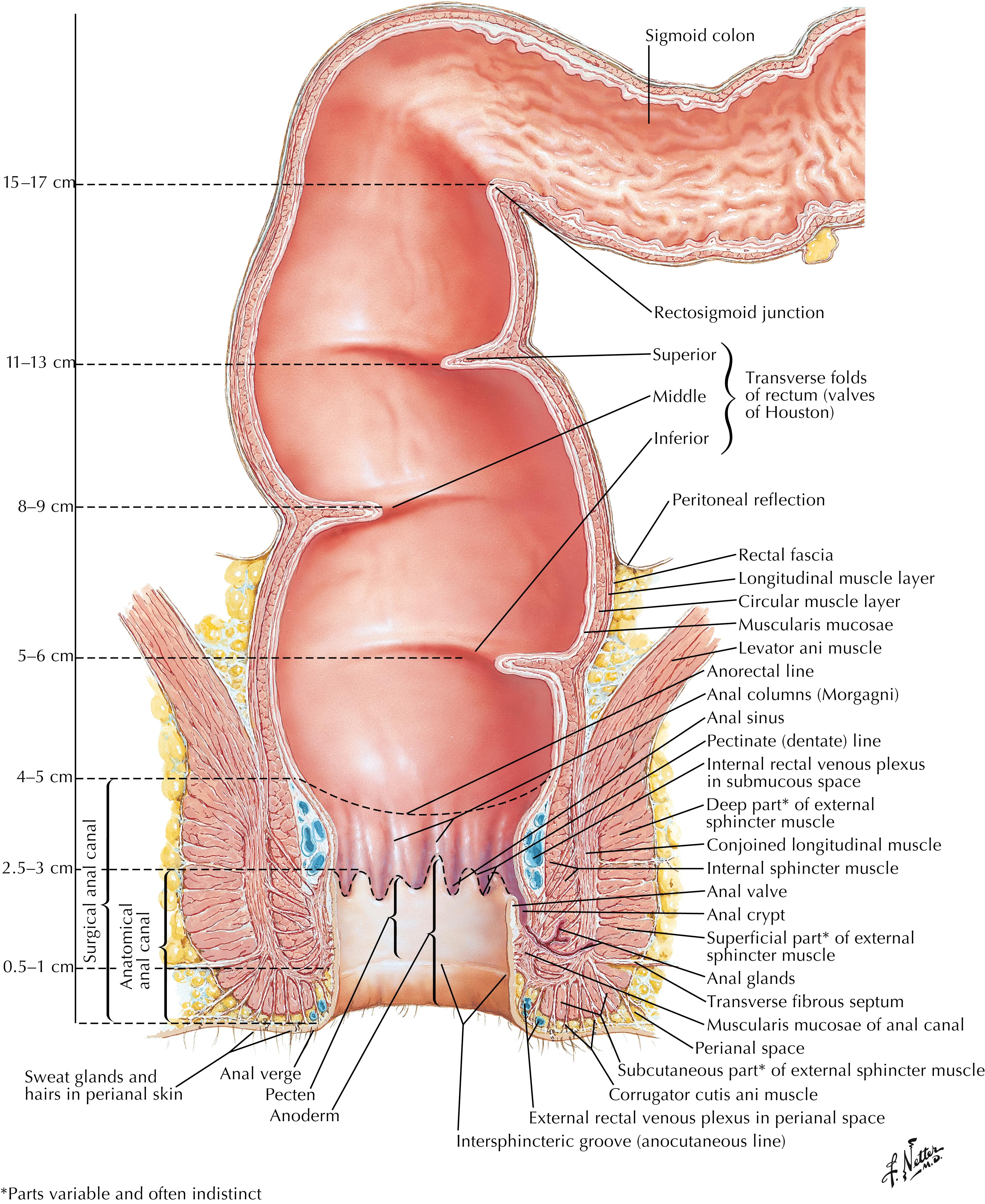
The mucosa above the dentate line appears pleated with longitudinal folds, known as the columns of Morgagni. There is a small pocket or crypt at the base of most columns that communicate with the anal glands, which secrete lubricating fluid to assist with defecation. The glands number from 6 to 12 and are mostly concentrated in the posterior aspect of the anus. The anal gland duct traverses the submucosal plane and its branches terminate within the internal anal sphincter or extend into the intersphincteric plane. These glands are of substantial clinical importance; foreign debris may obstruct the ducts and result in the common perianal abscess, and its chronic counterpart, the fistula-in-ano.
The submucosa in the area of the distal anal canal is formed by a discontinuous layer of thickened tissue creating hemorrhoidal “cushions,” typically found in the left lateral, right anterior, and right posterior positions. These cushions generally receive their blood supply from six hemorrhoidal arteries distributed along the circumference of the distal rectum and anus. The venous drainage is provided by the superior, middle, and inferior hemorrhoidal vessels, allowing for communication between the portal and systemic circulations. These vessels form direct arteriovenous communications within the cushions, and for this reason, hemorrhoidal bleeding is arterial rather than venous in nature. Venous and lymphatic drainage above the dentate line flows into the internal iliac vessels; below the dentate line, blood supply and drainage are provided by the inferior hemorrhoidal system.
The anal opening and anal canal remain virtually closed at rest as a result of tonic circumferential contraction of both the internal and external sphincters, and compression of the anal cushions. The internal anal sphincter is composed of autonomically innervated smooth muscle and contributes between 50% to 85% of the resting tone of the anal canal. Anatomically, the internal anal sphincter is a thickened continuation of the circular layer of the muscularis propria of the distal rectum and occupies the distal 2 to 4 cm of the anal canal. The external anal sphincter is a funnel-shaped structure composed of the pelvic floor muscles enveloping the distal rectum and anus. The puborectalis muscle, often referred to as the rectal sling, is one of the main muscles contributing to the external anal sphincter. It originates at the pubis, passes around the rectum posteriorly, and returns to the pubis. The external anal sphincter is unique because it can be controlled both by the autonomic nervous system and by voluntary contraction. In response to increases in intraabdominal pressure or rectal distention, the external anal sphincter and puborectalis reflexively and voluntarily contract to prevent fecal leakage. Unlike the internal anal sphincter, the external anal sphincter can be subjected to muscular fatigue with maximal voluntary contraction sustained for only 30 to 60 seconds.
The internal anal sphincter is supplied by sympathetic (L5) and parasympathetic (S2, S3, and S4) nerves. The external anal sphincter is innervated on each side by the inferior rectal branch of the pudendal nerve (S2 and S3) and by the perineal branch of S4. Even though the puborectalis and external anal sphincter have somewhat different innervation, these muscles appear to act as a unit. There is considerable redundancy in innervation of the anal sphincter— unilateral interruption of the pudendal nerve will not result in external anal sphincter dysfunction, but the loss of bilateral S3 nerve roots (e.g., by surgical transection) will typically result in fecal incontinence. If the S1 through S3 nerve roots remain intact only on one side, the patient is still expected to maintain control of the anal sphincters.
The rectal branch of the pudendal nerve transmits anal sensation, and it is thought to play a role in maintenance of anal continence. The anal canal contains a rich supply of free and organized sensory nerve endings, especially in the region of the anus. Organized nerve endings include Meissner corpuscles (touch), Krause bulbs (temperature sensation), Golgi-Mazzoni bodies (pressure), and genital corpuscules (friction).
The process of defecation is a complex coordinated event involving increased intraabdominal pressure, rectal contraction, and synchronized relaxation of the anal sphincters. Distention of the rectum results in reflexive relaxation of the internal anal sphincter. This allows sensory epithelium of the anus to sample the fecal material in order to distinguish between solid stool, liquid stool, and gas. If defecation is deemed appropriate, the external anal sphincter relaxes together with the puborectalis muscle, which allows straightening of the rectoanal angle, opening of the anal canal, and evacuation of fecal material.
The physiology of continence is as complex as defecation. Continence requires rectal wall compliance to accommodate the fecal material, appropriate neurogenic control of the pelvic floor muscles, and properly functioning internal and external sphincter muscles. At rest, the puborectalis muscle creates a sling around the distal rectum, forming a relatively acute rectoanal angle that distributes intraabdominal forces onto the pelvic floor. With defecation, this angle straightens, allowing downward force to be applied along the axis of the rectum and anus. The internal anal and external sphincters, together with the hemorrhoidal cushions, provide a complete airtight and watertight seal.
Most patients with clinically relevant diseases of the anus present with nonspecific complaints including rectal pain, bleeding, tissue prolapse, seepage, or anal itching. The skilled provider asks the focused questions that usually elucidate the nature of the problem. Patient history is the cornerstone of diagnosis and asking the right questions will almost always lead to a presumptive or even definitive diagnosis. It is pivotal that the provider has formed an impression of the likely problem before proceeding with the examination of the anus.
The history taking often includes detailed questioning about defecation. It is not sufficient to ask if the patient has “normal” bowel movements because most patients may believe/say that they do; rather, the number of daily bowel movements, straining with defecation, caliber of stool and consistency of bowel movements (soft, formed, liquid, or diarrhea), incontinence episodes, seepage, and soiling should be sought. A provider must inquire about the presence or absence of blood per anus, the character of the bleeding (bright vs. dark, amount of blood, presence or absence of blood clots), association with bowel movements, blood mixed within the fecal material or present as streaks of blood on stool, and whether blood is noted with wiping.
Anal pain or pressure is frequently a presenting complaint. Differentiating the type of pain can help accurately diagnose many conditions prior to examining the patient, as the common diagnoses typically present in distinct ways. Sharp, razor knife pain that occurs with bowel movements will almost always indicate an anal fissure. Pain occurring even without defecation, especially with bleeding, could indicate malignancy. Acute pain of relatively short duration may suggest a thrombosed hemorrhoid: when associated with fever and malaise, a perianal or ischiorectal abscess is a likely culprit.
Anal itching is a common and frustrating complaint, both for the patient and provider. The patient should be asked about the presence or absence of anal seepage or drainage, fecal soilage, or perianal moisture. Tactful questioning regarding sexual history, particularly anoreceptive intercourse, should be obtained from both men and women. Questions may include the number of partners, use of protection, sex without a partner, and a history of sexual trauma. If high-risk sexual behavior is reported, a focus on sexually transmitted diseases (STDs) and human immunodeficiency virus (HIV) status is suggested. Focused surgical history should include previous interventions for drainage of perirectal abscesses, fistula, hemorrhoid surgery, or sphincterotomy. Women should be asked about vaginal tears during delivery and a history of episiotomy.
Anorectal examination in an outpatient setting should be tailored to the presenting complaints, as the patient may be very sensitive or uncomfortable with the examination. Again, the history will almost provide for at least a presumptive or differential diagnosis. Communication with the patient is the key. The provider should inform the patient of the proposed examination and ensure the patient is comfortable with proceeding. It is appropriate to have a chaperone present in the room throughout the examination. The patient can be examined either in the knee-chest or Sims position; the latter being much more comfortable option for the patient, though perhaps more cumbersome for the provider.
The examination begins by observing the perianal skin and anal margin. Gentle spreading of the buttocks will reveal the anal verge and anoderm. The patient can be asked to squeeze and relax their sphincter muscle, which can reveal asymmetrical contraction or abnormal recruitment of the gluteus muscles to aid with anal squeeze. When asked to bear down, the patient is expected to reflexively relax their anal sphincter and may reveal rectal prolapse and/or abnormal pelvic floor descent.
Digital rectal examination is performed next. Before inserting the examining finger into the anal canal, a gentle tap with a well-lubricated finger on the anoderm will allow the patient an opportunity to prepare for the exam. Digital rectal examination begins with evaluation of the length of the surgical anal canal to the top of puborectalis sling posteriorly, followed by a sweep around the sacrum with palpation of the tip of the coccyx and evaluation of the levator muscles on the posterolateral aspect of the rectal vault. In men, the prostate is palpated anteriorly; in women, the presence of a rectocele may be determined by gently flexing the examining finger anteriorly. If a mass is detected within the rectum or anal canal, its location, relationship to the anterior-posterior or lateral aspect of the rectum should be noted, size should be estimated, and the provider should observe if it is fixed or mobile and soft or firm.
Prior to concluding the digital rectal examination, the patient is asked to squeeze, which is followed by bearing down. With a Valsalva maneuver, the muscles of the internal and external sphincters should relax, indicating appropriate coordination of the anal sphincter complex. Particular attention should be paid to digital examination of the anus, which can be overlooked if the provider palpates only the rectal vault. Using the first phalanx of the examining finger, a sweep of the anal canal should be performed. The provider should feel for masses or other irregularities.
Anoscopy is a common adjunct to digital rectal examination. The objective of the anoscopic evaluation is to visually inspect the anus and distal rectal mucosa. It can be useful for evaluating suspected enlarged hemorrhoids, anal dysplasia, intraanal condyloma acuminata, or anal tags. If purulent drainage is noted, it may be swabbed for evaluation of an STD as applicable.
Endoanal ultrasound may be used to evaluate the layers of the anal canal, internal anal sphincter, external sphincters, and puborectalis muscle. Ultrasound can be a used to accurately estimate the degree of anal sphincter disruption and to outline the anatomy of a complex anal fistula. Magnetic resonance imaging (MRI) is more sensitive than computed tomography (CT) for detecting pelvic lesions, and in defining the relationship to the pelvic muscular structures or pelvic sidewall. MRI can accurately determine the extent to which the distal rectal or anal cancer has spread into the adjacent mesorectum and pelvic organs, such as prostate or vagina, and it can reliably predict if the radial margin is threatened prior to surgical excision. MRI can be quite useful in detection and delineation of a complex fistula-in-ano.
Anorectal manometry provides a detailed physiologic assessment of anorectal function. This test measures the pressures generated by the anal sphincter muscles, sensation in the rectum, and the neural reflexes that are needed for normal bowel function. Using specially designed catheters and balloons, anorectal manometry and balloon expulsion testing provides important insights into the pathophysiology underlying incontinence and defecatory disorders and may serve as a guide to treatment.
Symptomatic hemorrhoids result from enlargement and/or protrusion of the anal hemorrhoidal cushions. The key etiologic factors contributing to the development of hemorrhoids include constipation and prolonged straining. Increased intraanal pressure leads to abnormal dilatation and engorgement of vascular channels, followed by chronic changes in the supporting connective tissue within the anal cushions. An inflammatory reaction and vascular hyperplasia , may be evident in hemorrhoids. With time and aging, starting as early as the second or third decade of life, the tissue supporting hemorrhoids can deteriorate or weaken, leading to distal displacement of the cushions and venous distention, erosion, bleeding, thrombosis, and/or tissue prolapse.
Painless bleeding associated with bowel movements with or without intermittent tissue protrusion is the most common complaint of patients with symptomatic internal hemorrhoids. Focus should be on the extent, severity, and duration of symptoms such as bleeding and prolapse, issues of perineal hygiene, and the presence or absence of pain. A detailed review of fiber intake and bowel habits, including frequency, consistency, change in caliber of stool, and difficulty with evacuation, should also be sought. An assessment of fecal continence is helpful in guiding treatment decisions. Anorectal examination should include visual inspection of the anus, digital rectal examination, and anoscopy to evaluate the extent of hemorrhoidal disease and search for other abnormalities. Internal hemorrhoids can be assigned a grade based on the classification in Table 53.1 .
| Grade of Internal Hemorrhoids | Description |
|---|---|
| Grade 1 | No prolapse; hemorrhoidal bleeding |
| Grade 2 | Hemorrhoids with bleeding and protrusion; reduce spontaneously |
| Grade 3 | Hemorrhoids with bleeding and protrusion; manual reduction required |
| Grade 4 | Prolapsed hemorrhoids that cannot be reduced |
The initial approach to a patient with symptomatic hemorrhoids usually includes the recommendation to increase fluid intake and start on fiber supplementation, along with counseling regarding defecation habits, such as avoidance of straining and limiting time on the toilet. The patient should be encouraged to drink at least 64 ounces of water per day and take fiber supplements with the goal of increasing the bulk of fecal material and caliber of stools. Even those patients who regularly consume dietary fiber and report having “normal” bowel movements will commonly benefit from additional fiber and water intake. Topical treatments for symptomatic hemorrhoids may include sitz baths 2 to 3 times per day and application of witch hazel topical pads as needed. A 6- to 8-week trial of medical management is usually indicated before considering more aggressive interventions.
Most patients with grade I and II (and select patients with grade III) internal hemorrhoidal disease who remain symptomatic despite medical management can be offered an office-based procedure, such as rubber band ligation (RBL), sclerotherapy, or infrared coagulation (IRC). Hemorrhoidal RBL is commonly the most effective option, and has been shown to be superior to sclerotherapy and IRC. Band ligation strangulates hemorrhoidal tissue, which results in ischemia and necrosis of the prolapsing mucosa, followed by scar fixation to the rectal wall. This procedure alleviates symptoms by decreasing the size of the hemorrhoidal cushion and increasing the fixation of the hemorrhoidal tissue to the rectal wall, thus minimizing hemorrhoidal prolapse ( Fig. 53.2 ). RBL is generally well-tolerated because the rubber band is placed proximal to the dentate line, in the area of the anus devoid of somatic pain fibers. Sclerotherapy is accomplished by injection of a sclerosing agent directly into the hemorrhoid, which results in fibrosis of the submucosa with subsequent fixation of the hemorrhoidal tissue. The most commonly used sclerosing agents are 5% phenol in almond or vegetable oil and sodium tetradecyl sulfate. Injection is performed into the submucosa at the apex of a hemorrhoidal cushion, using approximately 1 ml of sclerosing agent. Sclerotherapy is appropriately offered to anticoagulated patients or those receiving antiplatelet therapy, who are often not optimal candidates for RBL or surgical excision. IRC utilizes direct application of infrared light resulting in protein coagulation within the hemorrhoid. This is most commonly used for grade I and II hemorrhoids.
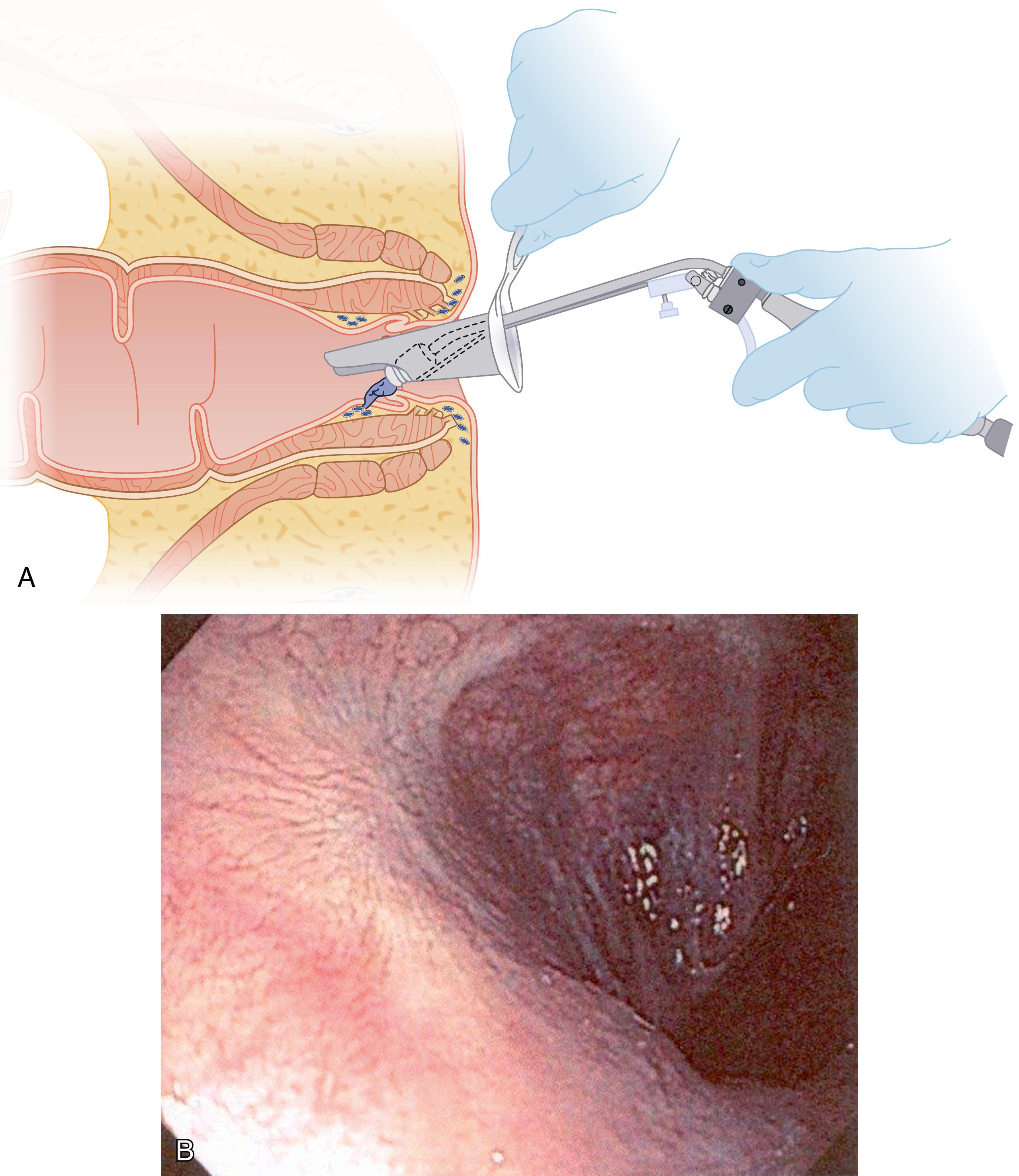
External hemorrhoids are characterized by distended vascular tissue distal to the dentate line. Patients with thrombosed external hemorrhoids typically present with severe anal pain that may be exacerbated by sitting or defecation ( Fig. 53.3 ). The thrombosed hemorrhoid is usually acute in onset and may be preceded by an episode of constipation or diarrhea. Most patients will experience resolution of their symptoms within 72 hours after the onset of symptoms with conservative measures, such as sitz baths, application of lidocaine ointment and stool softeners. Acutely tender, thrombosed external hemorrhoids are often surgically removed when pain is excessive and/or fails to respond to expectant management. Thrombectomy with evacuation of clot is often performed in the emergency department setting; however, excision of the hemorrhoid is usually a far better option, as it results in faster resolution of symptoms and a greatly decreased chance of recurrence. Both procedures may be readily accomplished with local anesthesia in an outpatient setting ( Fig. 53.4 ).
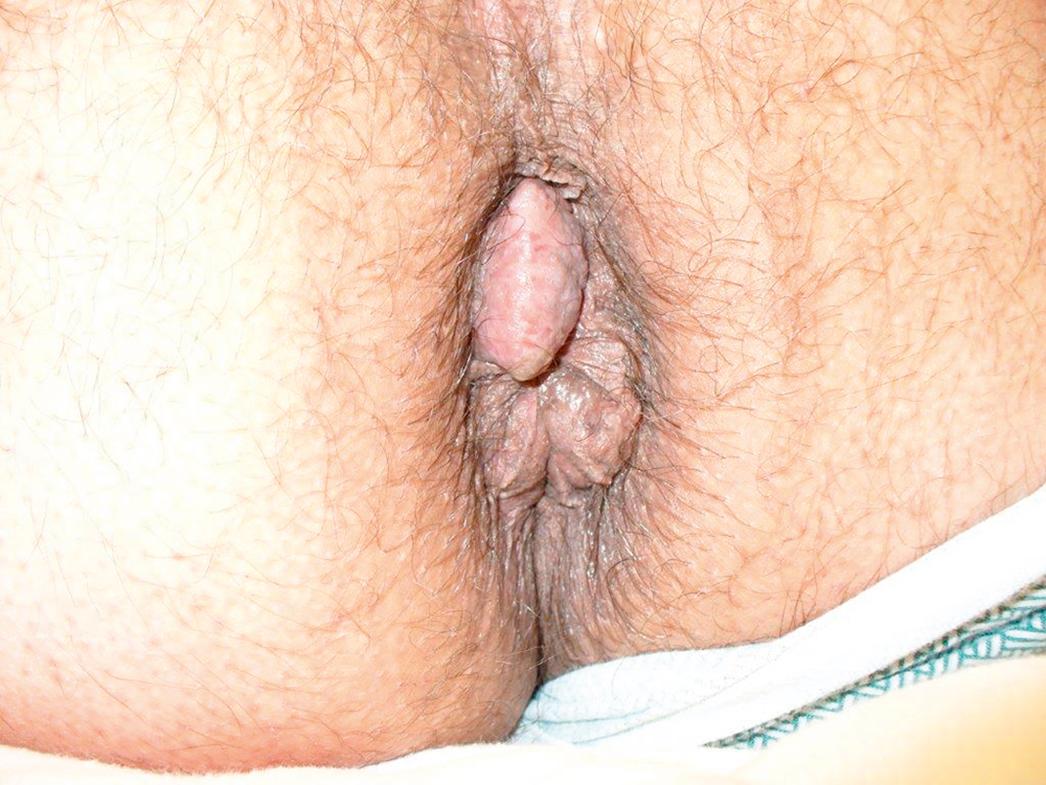
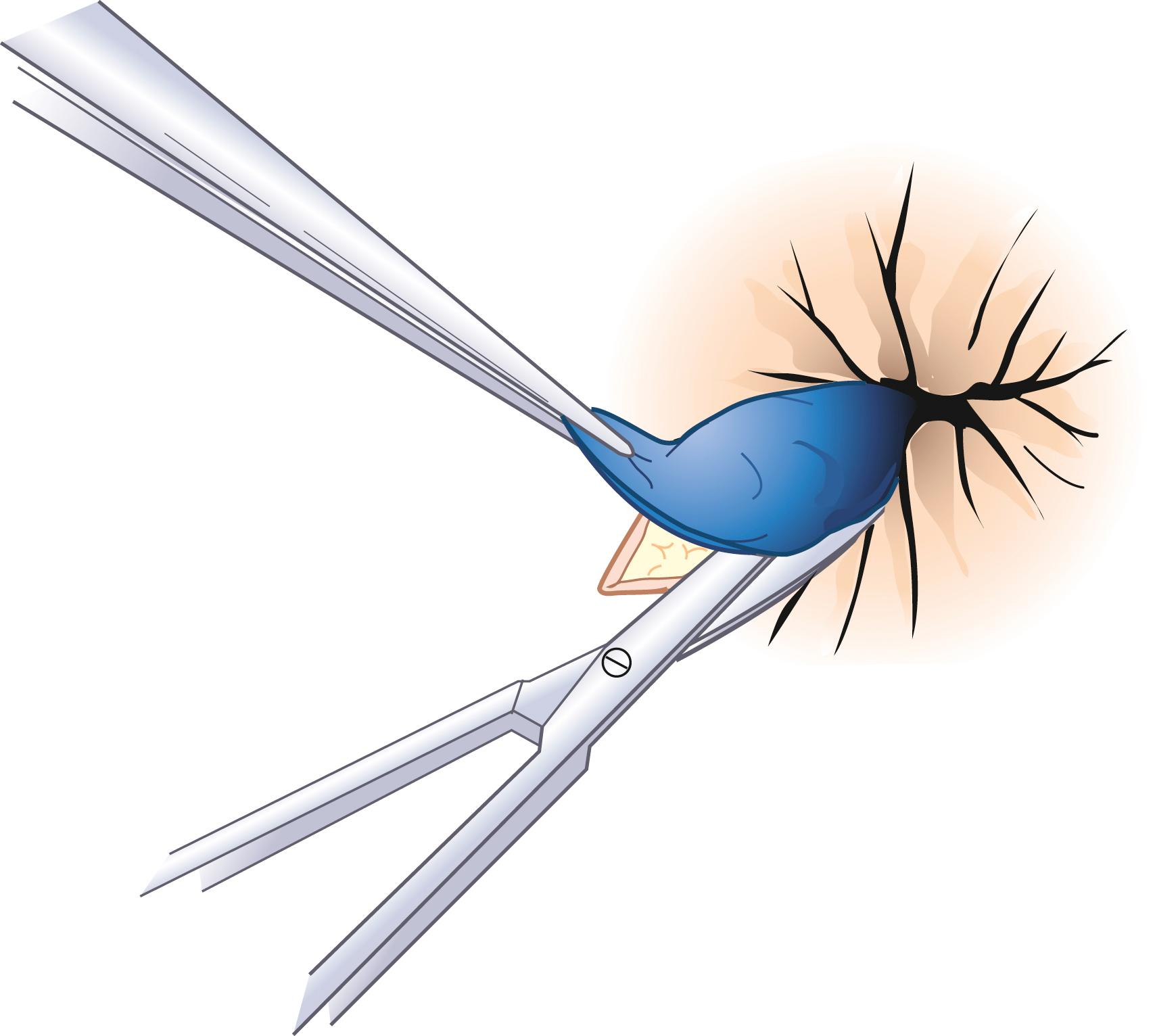
Surgical excision of hemorrhoids is a very effective, albeit painful, approach for patients who did not improve or who are not candidates for an office-based treatment. Excisional hemorrhoidectomy can be offered to patients with symptomatic combined internal and external hemorrhoids with prolapse (grades III–IV) or patients with substantial associated skin tags. Either open or closed hemorrhoidectomy can be performed with a variety of surgical devices. The most commonly used technique is the closed (Ferguson) hemorrhoidectomy ( Fig. 53.5 ). This approach is associated with decreased postoperative pain, faster wound healing, and a reduced risk of postoperative bleeding compared to an open (Milligan-Morgan) hemorrhoidectomy.
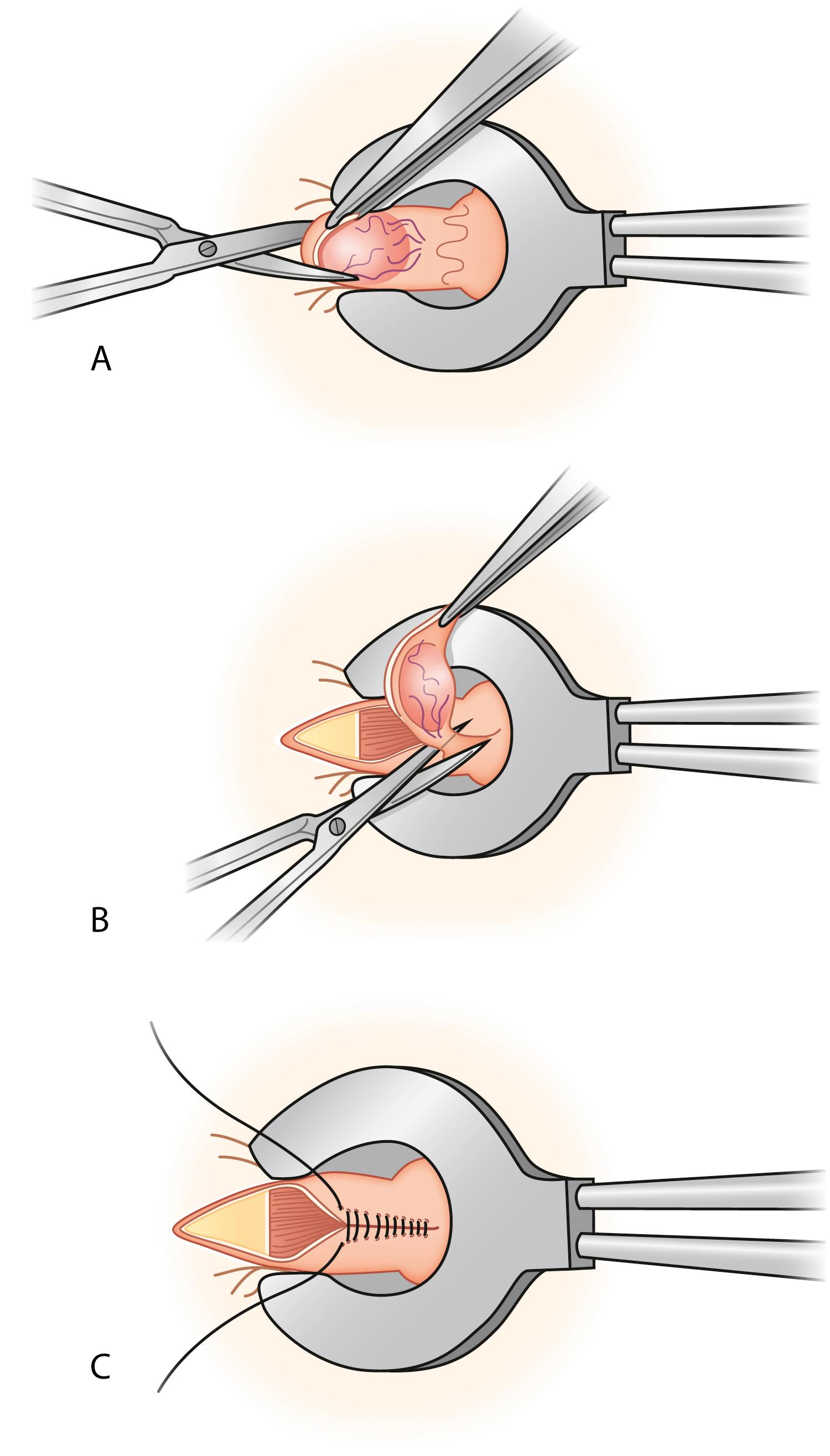
The principles of closed hemorrhoidectomy involve removal of only redundant hemorrhoidal tissue and pexy of hemorrhoidal mucosa to the rectal wall. In most instances, removal of the largest or most symptomatic hemorrhoid produces the desired symptomatic relief. Removal of all three hemorrhoidal columns can result in large mucosal defects and narrowing of the anal canal if not performed carefully. The procedure can be performed under general, local with monitored anesthesia, or spinal anesthesia. Prophylactic antibiotics are not indicated. Either lithotomy or the prone jack-knife position is acceptable. An anal block is induced with local anesthetic and exposure may be achieved with a Hill–Ferguson anoscope. The hemorrhoid is excised with a diamond-shaped excision extending onto the anoderm, using a scalpel, scissors, or energy device. Several bipolar or ultrasonic energy device-based techniques have been described. The use of a bipolar energy device was found to be faster and to cause less postoperative pain when compared with closed hemorrhoidectomy.
Regardless of the excision technique, the internal sphincter fibers should be identified and preserved. The base of the hemorrhoidal pedicle is oversewn with an absorbable braided suture to ligate the feeding arterial vessel. The edges of the hemorrhoidectomy wound are reapproximated with continuous locking braided absorbable suture. Complete hemostasis should be achieved with suture closure of the defect. If suture line bleeding is present, additional figure-of-eight sutures can be placed as needed. There is no benefit in packing the anal canal as it is unlikely to stop postoperative bleeding but can hide large quantities of blood accumulating above the packing.
Postoperative care should be aimed at maintaining regular bowel function with liberal use of milk of magnesia or polyethylene glycol laxatives to prevent constipation and impaction as needed. Pain is managed with sitz baths and judicious use of opioids. Complications after surgical hemorrhoidectomy are relatively low; the most common being postoperative hemorrhage, ranging in incidence between 1% and 2%. Acute urinary retention occurs between 1% and 15% of cases. A rare, but feared complication of hemorrhoidectomy is pelvic sepsis. It can develop after excisional hemorrhoidectomy or office-based procedures. Early symptoms are often nonspecific, and may include urinary dysfunction, worsening anal pain, or fever; a high degree of suspicion is required to diagnose this potentially life-threatening complication.
Stapled hemorrhoidopexy utilizes a specially designed stapling device to create a mucosa-to-mucosa anastomosis, while removing redundant mucosa proximal to the dentate line; the procedure also disrupts the feeding hemorrhoidal arteries and displaces the hemorrhoidal cushions into the proximal anal canal. Unlike excisional hemorrhoidectomy, this technique does not address external hemorrhoids. Despite initial favorable reports, stapled hemorrhoidopexy has been associated with several concerning complications such as rectovaginal fistula, staple line bleeding, chronic pain, and stricture at the staple line. In one study, 35 patients were identified who required laparotomy with fecal diversion, and one patient was treated by low anterior resection. Despite surgical treatment and resuscitation, there were 4 deaths.
Doppler-guided hemorrhoid artery ligation (HAL) utilizes a current understanding of the arterial blood supply of hemorrhoids to identify and ligate selected feeding vessels. There is no need for tissue excision, but mucosal pexy is required for patients with symptomatic hemorrhoidal prolapse. Several studies using HAL have demonstrated favorable short-term outcomes. This method, however, is expensive and was not found to be cost-effective compared with RBL in terms of incremental cost per quality-adjusted life-year.
An anal fissure is an elliptical or oval shaped tear in the anal canal starting at the anal verge and extending proximally for a varying length towards the dentate line ( Fig. 53.6 ). Acute fissures appear as a shallow tear in the anoderm. The most common symptom is sharp anal pain with defecation, often described by patients as the feeling of “passing pieces of glass or razor blades.” The sharp pain can be followed by throbbing and anal spasm. Anal bleeding can present as blood streaking on the stool or on the toilet paper. Anal fissures that are present for more than 6 to 8 weeks are considered to be chronic. Features of a chronic fissure include the presence of exposed internal sphincter fibers at the base, a hypertrophied anal papilla proximally, and a skin tag or sentinel pile distally. Pain with defecation tends to be less severe than with an acute fissure, but the symptoms are nonetheless unrelenting, and patients will often dread having bowel movements. Symptoms are commonly cyclical in nature, often making it challenging for patients to know whether any prescribed treatment is truly “helping.”
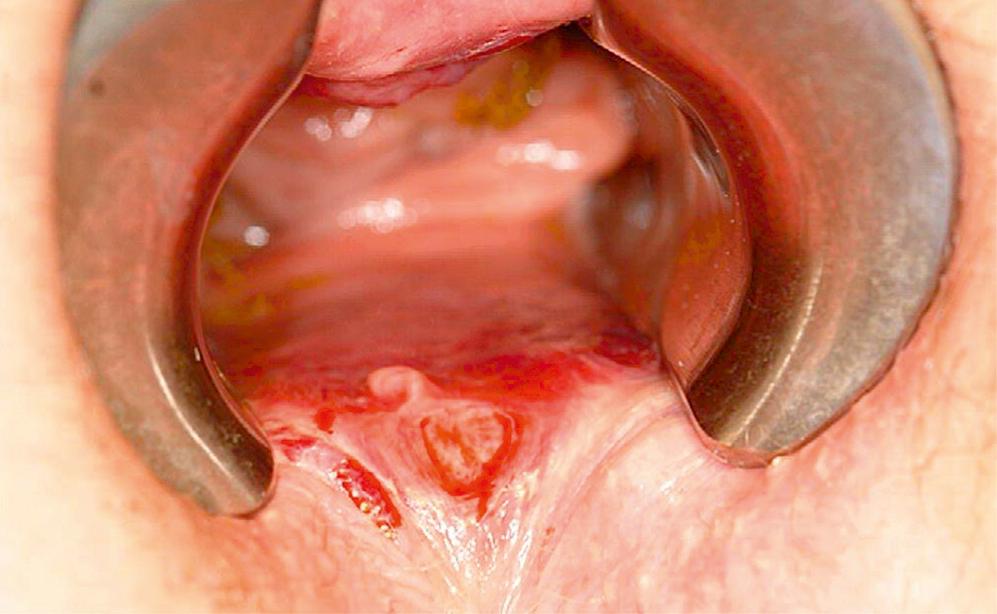
Fissures may occur as a result of a tear caused by passage of a hard stool, explosive diarrhea, anal receptive intercourse or anal trauma. This, in turn, results in anal sphincter spasm, which further exacerbates constipation, ultimately decreasing blood flow to the anal mucosa and relative ischemia at the site of the tear. The most common location of an anal fissure is the posterior midline (75%). Another frequent location is the anterior midline, which is more common in women. Anal fissures found off the midline are considered atypical. The differential diagnosis of atypical fissures includes Crohn disease, anal cancer, tuberculosis, HIV, syphilis, herpes, and leukemia ( Fig. 53.7 ).
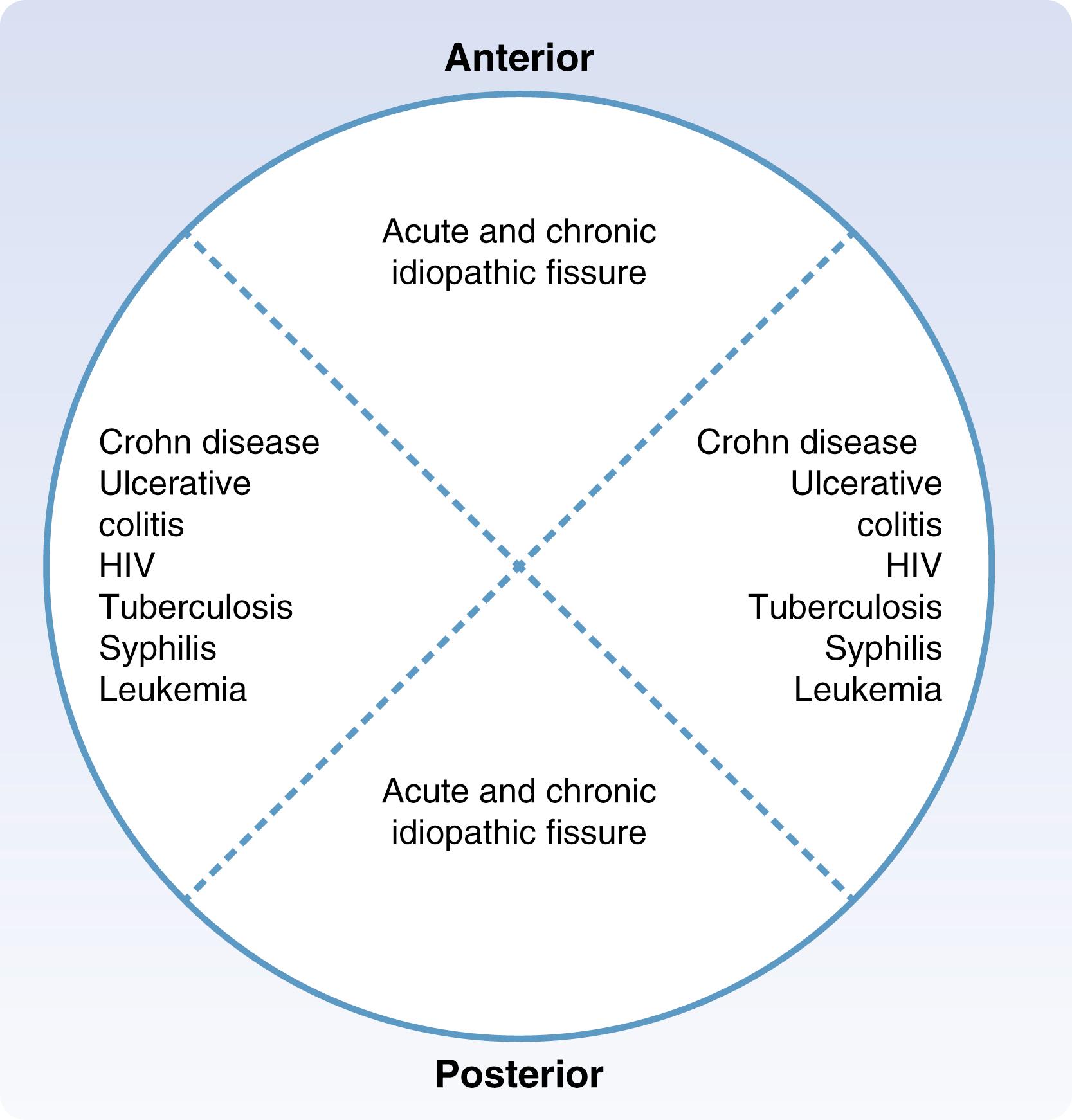
The diagnosis of an anal fissure is usually straightforward and can often be made based on the patient’s history alone. Gentle separation of the buttocks can reveal the fissure; however, just spreading the buttocks may cause intolerable pain and the examination may need to be stopped at this point. If the fissure is not clearly visible, gentle pressure with a cotton tip applicator on posterior and anterior aspect of the anal canal can reproduce the pain. Digital exam and anoscopic exam are often deferred to avoid exacerbating the patient’s pain. If the diagnosis is unclear, an examination under anesthesia may be necessary.
The majority of acute anal fissures resolve with medical management alone. Chronic fissures, however, are less likely to heal with exclusively conservative measures. The goals of treatment are aimed at (1) addressing the inciting factors such as constipation or other causes of anal trauma, (2) relaxation and dilation of the internal anal sphincter to improve blood flow and allow healing, and (3) addressing the symptoms of pain and bleeding. The initial step in management should be to increase fluid and fiber ingestion as well as sitz baths and may include mineral oil or stool softeners to help with lubrication. Topical application of nitrates and calcium channel blockers are often used as an adjunct in nonoperative management. This results in internal anal sphincter relaxation and vasodilation, leading to improved blood flow to the anal mucosa and healing of the fissure.
Botulinum toxin (BT) can produce potent and sustained relaxation of anal sphincter by inducing temporary paralysis of the anal sphincter muscle. A typical dose of 20 to 100 IU of BT will produce relaxation lasting approximately 3 months. Injection can be done safely in the office or may be performed as an outpatient procedure with sedation. Large studies have concluded that BT is associated with a modest increase in healing rates as second-line therapy following unsuccessful treatment with topical agents. Overall, healing rates of 65% were reported when BT injection was combined with concurrent topical application of diltiazem. The most common side effects of BT injection are temporary incontinence to flatus. Other side effects include increased urinary residual volume, heart block, skin irritation, and allergic reactions.
Lateral internal sphincterotomy (LIS) induces sustained partial relaxation of the internal anal sphincter and reduces anal sphincter tone, enabling healing of the anal fissure. A radial incision in the anoderm exposes the internal sphincter muscle fibers ( Fig. 53.8 ). The distal segment of the internal anal sphincter muscle is divided sharply for the length corresponding to that of the anal fissure. The wound can be left open or closed primarily. A closed LIS can be performed by inserting a narrow-bladed scalpel directly into the intersphincteric groove and dividing the internal sphincter laterally to medially toward the surgeon’s finger within the anal canal. LIS has shown to be superior to topical nitrates, calcium channel blockers, or BT, with healing rates of 88% to 100%. Reported rates of fecal incontinence after LIS rates range from 8% to 30% but is usually limited to minor episodes of incontinence to flatus, most often in the first 30 days after the procedure.
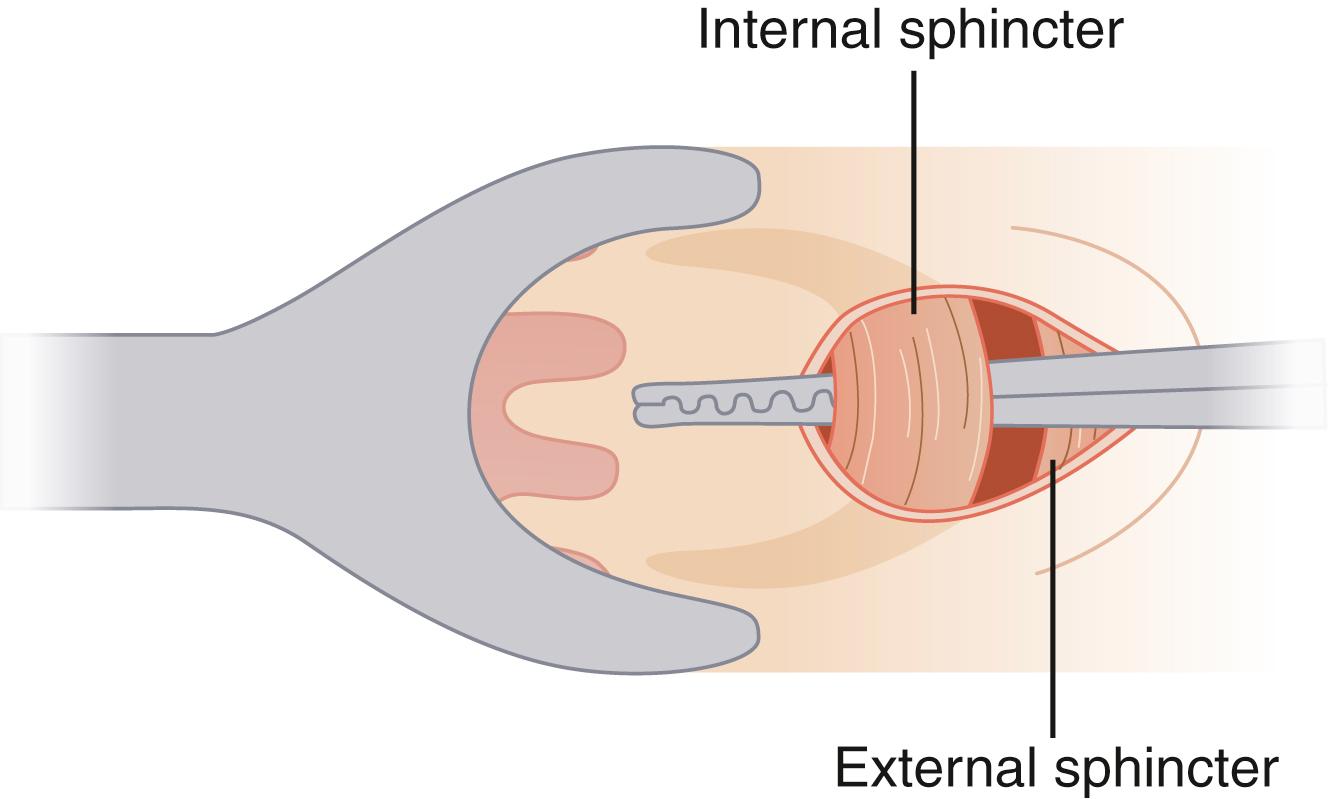
Become a Clinical Tree membership for Full access and enjoy Unlimited articles
If you are a member. Log in here